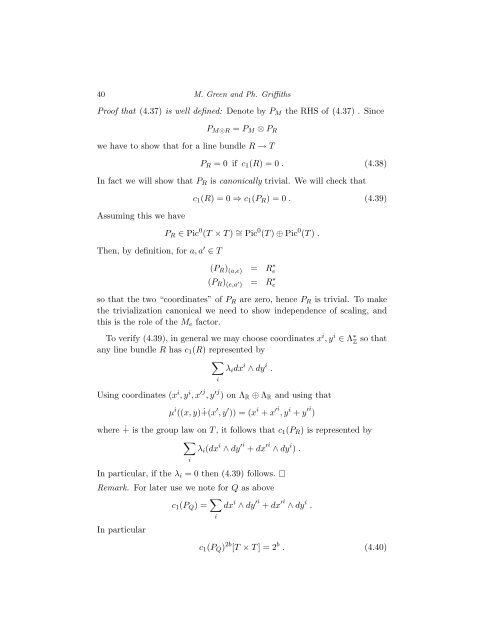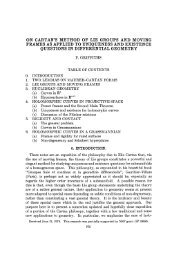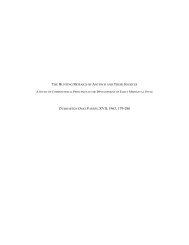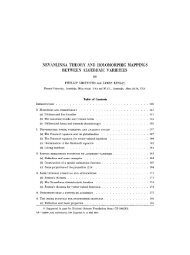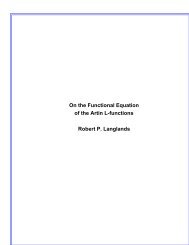4 Algebraic Cycles and Singularities of Normal Functions
4 Algebraic Cycles and Singularities of Normal Functions
4 Algebraic Cycles and Singularities of Normal Functions
You also want an ePaper? Increase the reach of your titles
YUMPU automatically turns print PDFs into web optimized ePapers that Google loves.
40 M. Green <strong>and</strong> Ph. Griffiths<br />
Pro<strong>of</strong> that (4.37) is well defined: Denote by PM the RHS <strong>of</strong> (4.37) . Since<br />
PM⊗R = PM ⊗ PR<br />
we have to show that for a line bundle R → T<br />
PR =0 if c1(R) =0. (4.38)<br />
In fact we will show that PR is canonically trivial. We will check that<br />
Assuming this we have<br />
Then, by definition, for a, a ′ ∈ T<br />
c1(R) =0⇒ c1(PR) =0. (4.39)<br />
PR ∈ Pic 0 (T × T ) ∼ = Pic 0 (T ) ⊕ Pic 0 (T ) .<br />
(PR) (a,e) = R ∗ e<br />
(PR) (e,a ′ ) = R ∗ e<br />
so that the two “coordinates” <strong>of</strong> PR are zero, hence PR is trivial. To make<br />
the trivialization canonical we need to show independence <strong>of</strong> scaling, <strong>and</strong><br />
this is the role <strong>of</strong> the Me factor.<br />
To verify (4.39), in general we may choose coordinates x i ,y i ∈ Λ ∗ Z<br />
any line bundle R has c1(R) represented by<br />
<br />
i<br />
λidx i ∧ dy i .<br />
Using coordinates (x i ,y i ,x ′j ,y ′j )onΛR ⊕ ΛR <strong>and</strong> using that<br />
µ i ((x, y) ˙+(x ′ ,y ′ )) = (x i + x ′i ,y i + y ′i )<br />
where ˙+ is the group law on T , it follows that c1(PR) is represented by<br />
<br />
i<br />
λi(dx i ∧ dy ′i + dx ′i ∧ dy i ) .<br />
In particular, if the λi = 0 then (4.39) follows.<br />
Remark. For later use we note for Q as above<br />
c1(PQ) = <br />
In particular<br />
i<br />
dx i ∧ dy ′i + dx ′i ∧ dy i .<br />
so that<br />
c1(PQ) 2b [T × T ]=2 b . (4.40)


